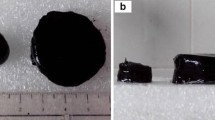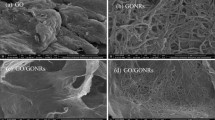Abstract
In our research, thiolated reduced graphene oxide aerogels (TrGOAs) was successfully prepared by using graphene oxide (GO) as precursor and sodium hydrosulfide (NaSH) as reductant via a one-pot one-step hydrothermal route under normal pressure and a subsequent freeze-drying, used as a novel carbon-based adsorptive material for adsorbing Cu(II) ions from deionized water. These aerogels show excellent adsorption ability towards Cu(II) ions, which have a huge adsorption amount around 421.21 mg·g−1. We studied the mechanism of the adsorption process of TrGOA-5, and the results found that the pseudo-second-order kinetic model and the Freundlich isotherm model were able to describe this process well. We also explored the interference of pH values in copper ion solutions during this adsorption process, suggesting that increasing pH is good for obtaining a higher adsorption capacity. In addition, solid-liquid separation can be readily realized by filtration and centrifugation after the end of the adsorption experiment. Overall, this research offers a relatively simple and cut-price strategy to obtain thiolated reduced graphene oxide aerogels, and these novel graphene-based adsorbents have a superior adsorption ability and recyclability in segregating copper ions from polluted water.







Similar content being viewed by others
References
Al-Saydeh, S. A., El-Naas, M. H., & Zaidi, S. J. (2017). Copper removal from industrial wastewater: A comprehensive review. Journal of Industrial and Engineering Chemistry, 56, 35–44.
Alyuz, B., & Veli, S. (2009). Kinetics and equilibrium studies for the removal of nickel and zinc from aqueous solutions by ion exchange resins. Journal of Hazardous Materials, 167, 482–488.
Biškup, B., & Subotić, B. (2005). Removal of heavy metal ions from solutions using zeolites. III. Influence of sodium ion concentration in the liquid phase on the kinetics of exchange processes between cadmium ions from solution and sodium ions from zeolite a. Separation Science and Technology, 39, 925–940.
Chen, D., Zhang, H., Yang, K., & Wang, H. (2016). Functionalization of 4-aminothiophenol and 3-aminopropyltriethoxysilane with graphene oxide for potential dye and copper removal. Journal of Hazardous Materials, 310, 179–187.
Chowdhury, S., & Balasubramanian, R. (2014). Recent advances in the use of graphene-family nanoadsorbents for removal of toxic pollutants from wastewater. Advances in Colloid and Interface Science, 204, 35–56.
Ding, Z., Hu, X., Morales, V. L., & Gao, B. (2014). Filtration and transport of heavy metals in graphene oxide enabled sand columns. Chemical Engineering Journal, 257, 248–252.
Dong, Z., Zhang, F., Wang, D., Liu, X., & Jin, J. (2015). Polydopamine-mediated surface-functionalization of graphene oxide for heavy metal ions removal. Journal of Solid State Chemistry, 224, 88–93.
Fan, Z., Yan, J., Zhi, L., Zhang, Q., Wei, T., Feng, J., Zhang, M., Qian, W., & Wei, F. (2010). A three-dimensional carbon nanotube/graphene sandwich and its application as electrode in supercapacitors. Advanced Materials, 22, 3723–3728.
Geng, B., Wang, H., Wu, S., Ru, J., Tong, C., Chen, Y., Liu, H., Wu, S., & Liu, X. (2017). Surface-tailored nanocellulose aerogels with thiol-functional moieties for highly efficient and selective removal of Hg(II) ions from water. ACS Sustainable Chemistry & Engineering, 5, 11715–11726.
Han, Z., Tang, Z., Shen, S., Zhao, B., Zheng, G., & Yang, J. (2014). Strengthening of graphene aerogels with tunable density and high adsorption capacity towards Pb2+. Scientific Report, 4, 5025.
Han, Q., Chen, L., Li, W., Zhou, Z., Fang, Z., Xu, Z., & Qian, X. (2018). Self-assembled three-dimensional double network graphene oxide/polyacrylic acid hybrid aerogel for removal of cu(2+) from aqueous solution. Environmental Science and Pollution Research, 25, 34438–34447.
Hou, P., Xing, G., Han, D., Wang, H., Yu, C., & Li, Y. (2018). Preparation of zeolite imidazolate framework/graphene hybrid aerogels and their application as highly efficient adsorbent. Journal of Solid State Chemistry, 265, 184–192.
Hu, C., Liu, Y., Yang, Y., Cui, J., Huang, Z., Wang, Y., Yang, L., Wang, H., Xiao, Y., & Rong, J. (2013a). One-step preparation of nitrogen-doped graphenequantum dots from oxidized debris of graphene oxide. Journal of Materials Chemistry B, 1, 39–42.
Hu, X.-j., Liu, Y.-g., Wang, H., Chen, A.-w., Zeng, G.-m., Liu, S.-m., Guo, Y.-m., Hu, X., Li, T.-t., Wang, Y.-q., Zhou, L., & Liu, S.-h. (2013b). Removal of Cu(II) ions from aqueous solution using sulfonated magnetic graphene oxide composite. Separation and Purification Technology, 108, 189–195.
Huang, J., & Yan, Z. (2018). Adsorption mechanism of oil by resilient Graphene aerogels from oil-water emulsion. Langmuir., 34, 1890–1898.
Huang, Y., Zhu, J., Liu, H., Wang, Z., & Zhang, X. (2018). Preparation of porous graphene/carbon nanotube composite and adsorption mechanism of methylene blue, SN. Applied Sciences, 1.
Kim, J. D., Palani, T., Kumar, M. R., Lee, S., & Choi, H. C. (2012). Preparation of reusable Ag-decorated graphene oxide catalysts for decarboxylative cycloaddition. Journal of Materials Chemistry, 22, 20665.
Kobya, M. (2004). Removal of Cr(VI) from aqueous solutions by adsorption onto hazelnut shell activated carbon: Kinetic and equilibrium studies. Bioresource Technology, 91, 317–321.
Krishna Kumar, A. S., Jiang, S.-J., & Tseng, W.-L. (2016). Facile synthesis and characterization of thiol-functionalized graphene oxide as effective adsorbent for Hg(II). Journal of Environmental Chemical Engineering, 4, 2052–2065.
Lashkor, M., Rawson, F. J., Preece, J. A., & Mendes, P. M. (2014). Switching specific biomolecular interactions on surfaces under complex biological conditions. Analyst., 139, 5400–5408.
Li, D., & Kaner, R. B. (2008). Materials science. Graphene-based materials. Science, 320, 1170–1171.
Li, X., Zhou, H., Wu, W., Wei, S., Xu, Y., & Kuang, Y. (2015). Studies of heavy metal ion adsorption on chitosan/sulfydryl-functionalized graphene oxide composites. Journal of Colloid and Interface Science, 448, 389–397.
Liang, C.-Z., Sun, S.-P., Li, F.-Y., Ong, Y.-K., & Chung, T.-S. (2014). Treatment of highly concentrated wastewater containing multiple synthetic dyes by a combined process of coagulation/flocculation and nanofiltration. Journal of Membrane Science, 469, 306–315.
Liu, J., Du, H., Yuan, S., He, W., & Liu, Z. (2015). Synthesis of thiol-functionalized magnetic graphene as adsorbent for cd(II) removal from aqueous systems. Journal of Environmental Chemical Engineering, 3, 617–621.
Liu, J., Xiao, G., Ye, X., Wang, G., Zhang, H., Zhou, H., Zhang, Y., & Zhao, H. (2016). 3D graphene/□-MnO2 aerogels for high efficient and reversible removal of heavy metal ions. Journal of Materials Chemistry A, 4, 1970–1979.
Mi, X., Huang, G., Xie, W., Wang, W., Liu, Y., & Gao, J. (2012). Preparation of graphene oxide aerogel and its adsorption for Cu2+ ions. Carbon, 50, 4856–4864.
Min, Y., Qi, X. F., Xu, Q., & Chen, Y. (2014). Enhanced reactive oxygen species on a phosphate modified C3N4/graphene photocatalyst for pollutant degradation. CrystEngComm, 16, 1287.
Mukherjee, R., Bhunia, P., & De, S. (2016). Impact of graphene oxide on removal of heavy metals using mixed matrix membrane. Chemical Engineering Journal, 292, 284–297.
Neal, A. L., Techkarnjanaruk, S., Dohnalkova, A., Mccready, D., Peyton, B. M., & Geesey, G. G. (2001). Iron sulfides and sulfur species produced at hematite surfaces in the presence of sulfate-reducing bacteria. Geochimica et Cosmochimica Acta, 65, 223–235.
Nguyen, N., Lee, J.-c., Jha, M., Yoo, K., & Jeong, J. (2009). Copper recovery from low concentration waste solution using Dowex G-26 resin. Hydrometallurgy, 97, 237–242.
Pan, L., Wang, Z., Yang, Q., Huang, R. (2018). Efficient removal of lead, copper and cadmium ions from water by a porous calcium alginate/graphene oxide composite aerogel, nanomaterials-basel 8.
Pham, C. V., Eck, M., & Krueger, M. (2013). Thiol functionalized reduced graphene oxide as a base material for novel graphene-nanoparticle hybrid composites. Chemical Engineering Journal, 231, 146–154.
Shen, H., Chen, J., Dai, H., Wang, L., Hu, M., & Xia, Q. (2013). New insights into the sorption and detoxification of chromium (VI) by tetraethylenepentamine functionalized nanosized magnetic polymer adsorbents: Mechanism and pH effect. Industrial and Engineering Chemistry Research, 52, 12723–12732.
Sommella, A., Caporale, A. G., Denecke, M. A., Mangold, S., Pigna, M., Santoro, A., Terzano, R., & Violante, A. (2015). Nature and reactivity of layered double hydroxides formed by coprecipitating Mg, Al and As(V): Effect of arsenic concentration, pH, and aging. Journal of Hazardous Materials, 300, 504–512.
Sun, Y., Shao, D., Chen, C., Yang, S., & Wang, X. (2013). Highly efficient enrichment of radionuclides on graphene oxide-supported polyaniline. Environmental Science & Technology, 47, 9904–9910.
Tajima, K., Isaka, T., Yamashina, T., Ohta, Y., Matsuo, Y., & Takai, K. (2017). Functional group dependence of spin magnetism in graphene oxide. Polyhedron, 136, 155–158.
Tian, W., Gao, Q., Tan, Y., Zhang, Y., Xu, J., Li, Z., Yang, K., Zhu, L., & Liu, Z. (2015). Three-dimensional functionalized graphenes with systematical control over the interconnected pores and surface functional groups for high energy performance supercapacitors. Carbon, 85, 351–362.
Wang, S., Ning, H., Hu, N., Huang, K., Weng, S., Wu, X., Wu, L., & Liu, J. (2019). Alamusi, preparation and characterization of graphene oxide/silk fibroin hybrid aerogel for dye and heavy metal adsorption. Composites Part B: Engineering, 163, 716–722.
Wee, B. H., & Hong, J. D. (2014). Multilayered poly(p-phenylenevinylene)/reduced graphene oxide film: An efficient organic current collector in an all-plastic supercapacitor. Langmuir., 30, 5267–5275.
Wu, S., Zhang, K., Wang, X., Jia, Y., Sun, B., Luo, T., Meng, F., Jin, Z., Lin, D., Shen, W., Kong, L., & Liu, J. (2015). Enhanced adsorption of cadmium ions by 3D sulfonated reduced graphene oxide. Chemical Engineering Journal, 262, 1292–1302.
Xia, Z., Baird, L., Zimmerman, N., & Yeager, M. (2017). Heavy metal ion removal by thiol functionalized aluminum oxide hydroxide nanowhiskers. Applied Surface Science, 416, 565–573.
Yang, S. T., Chang, Y., Wang, H., Liu, G., Chen, S., Wang, Y., Liu, Y., & Cao, A. (2010). Folding/aggregation of graphene oxide and its application in Cu2+ removal. Journal of Colloid and Interface Science, 351, 122–127.
Yanwu, Z., Shanthi, M., Stoller, M. D., Ganesh, K. J., Weiwei, C., Ferreira, P. J., Adam, P., Wallace, R. M., Cychosz, K. A., & Matthias, T. (2011). Carbon-based supercapacitors produced by activation of graphene. Science, 332, 1537.
Zhang, N., Qiu, H., Si, Y., Wang, W., & Gao, J. (2011). Fabrication of highly porous biodegradable monoliths strengthened by graphene oxide and their adsorption of metal ions. Carbon, 49, 827–837.
Zhang, L., Li, H., Lai, X., Su, X., Liang, T., & Zeng, X. (2017). Thiolated graphene-based superhydrophobic sponges for oil-water separation. Chemical Engineering Journal, 316, 736–743.
Zhao, Y., Zhao, D., Chen, C., & Wang, X. (2013). Enhanced photo-reduction and removal of Cr (VI) on reduced graphene oxide decorated with TiO2 nanoparticles. Journal of Colloid and Interface Science, 405, 211–217.
Zhao, W., Tang, Y., Jia, X., & Jie, K. (2015a). Functionalized graphene sheets with poly(ionic liquid)s and high adsorption capacity of anionic dyes. Applied Surface Science, 326, 276–284.
Zhao, L., Yu, B., Xue, F., Xie, J., Zhang, X., Wu, R., Wang, R., Hu, Z., Yang, S. T., & Luo, J. (2015b). Facile hydrothermal preparation of recyclable S-doped graphene sponge for Cu2+ adsorption. Journal of Hazardous Materials, 286, 449–456.
Acknowledgments
The authors highly appreciate the State Key Laboratory of Polymer Materials Engineering for all the tests and the Analytical & Testing Center of Sichuan University for XPS work.
Author information
Authors and Affiliations
Corresponding author
Ethics declarations
Conflict of Interest
The authors declare that they have no conflicts of interest.
Additional information
Publisher’s Note
Springer Nature remains neutral with regard to jurisdictional claims in published maps and institutional affiliations.
Rights and permissions
About this article
Cite this article
Li, J., Bao, J. Facile Preparation of Thiolated Reduced Graphene Oxide Aerogels for Efficient Removal of Cu(II) Ion from Water. Water Air Soil Pollut 231, 565 (2020). https://doi.org/10.1007/s11270-020-04934-y
Received:
Accepted:
Published:
DOI: https://doi.org/10.1007/s11270-020-04934-y




